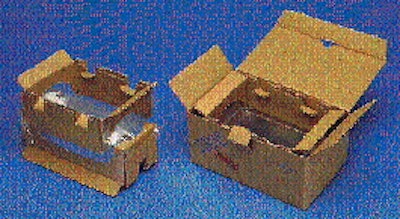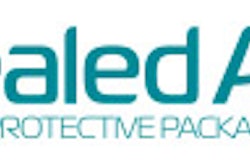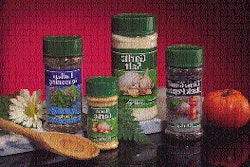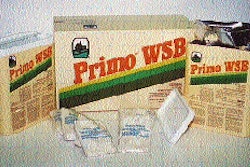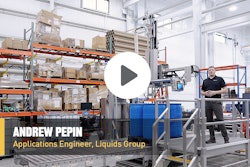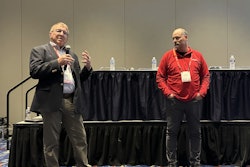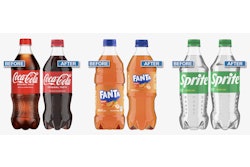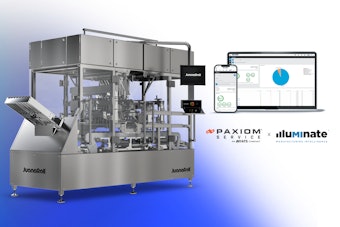When IBM's Custom Solutions Manufacturing Division took over packaging and distribution for hard disk drive kits, packaging engineer Nicolle Dutts asked if she could make a change. The problem? While the foamed polyurethane inserts inside a corrugated box were doing a fine job of protecting the low-profile hard drives, Dutts felt there was room to improve the pack's recyclability. After hearing about a new version of Sealed Air's (Danbury, CT) Korrvu® suspension pack designed specifically to protect low-profile products, she checked it out. Traditional Korrvu works better at trapping larger objects between two frames of taut, low-slip film. The design doesn't work as well for thinner products, which can shift between the frames. Sealed Air had been experimenting with what it calls the Korrvu Saddle Pack, a design that consists of two opposing U-shaped film frames that increase the tension on the product, virtually eliminating shifting during shipment. That pack was given the green light by IBM to protect the 0.75"-thick hard drives. It entered production in April '95, making the Charlotte, NC, division one of the first users of the new design. The benefits are many: * It costs less. While IBM won't reveal volumes, Dutts estimates a savings of 3¢ to 5¢/package over the foam. Tooling charges are lower, too, compared to cutting dies for prefabricated PU. (A new, corrugated box design with self-locking bottom and tuck top from Packaging Services of Carolina (Rockwell, NC) saves an additional 2 cents per package by eliminating the need for one of two tamper-evident labels.) * Aside from the corrugated box, there are only two Korrvu components versus three foam parts. And since the Korrvu parts are shipped flat, they take up 60% less warehouse space, important since storage space at the Charlotte facility is at a premium. * Even with the film, the package is 100% recyclable in along with other OCC (old corrugated containers) in any hydropulping operation, and is RESY-approved for recycling in Germany. Also, the suspension frames contain a minimum of 35% recycled content (post-consumer content unavailable) and the box contains at least 40% (with the corrugated medium consisting of 100% post-consumer fiber). * The package provides increased protection from shock and vibration compared to the PU foam, withstanding eight 36" drop tests with zero damage to the product inside. * The clear PU film, whose thickness and specifications Sealed Air won't divulge, permits easy pre- and post-transit product inspection, and also provides a more attractive presentation of the product. * Since one size of Korrvu can work with many similar hard drive sizes, it further reduces inventory of packaging components as other drive sizes are produced. Easy assembly Before the Korrvu frames are assembled, the 175#-test, B-flute carton itself, which measures 9.25" x 6" x 4.5", is manually "popped" into place, resulting in faster assembly. The carton's tamper-resistant bottom eliminates the need for a tamper-evident bottom label. Graphics on the carton are sparse-two colors printed via flexo-since this is an item that's not seen by consumers until after it is ordered and shipped. Assembly is simple. The bottom Korrvu frame, shipped flat, is set up by pushing pre-cut corrugated tabs into place. Instead of a flat frame of film, the film curves back at the left and right edges, following the bend of the corrugated. The net effect is that across the film's surface, there's a top and bottom corrugated frame but not a left and right frame. The hard drive-measuring 4.5" x 3.25" x 0.75"-is first inserted in a metallized electrostatic discharge (ESD) protective bag and then placed onto the film bed created by the bottom Korrvu frame. (The Korrvu film does not have anti-stat properties.) The top frame, also shipped flat, is similarly folded into place but with a vertical U-shape plane of film curving away at the top and bottom of the frame. The bottom frame is placed with the horizontal curve of the film opposed to the top frame's U-shaped vertical curve, trapping the product in between. Instruction manuals are then loaded in the cavity created by the top frame. To further increase the tension on the suspension windows, the frames are designed so that they must be pushed downward into the box before the top can be closed and sealed. (Since the box tucks closed, no gluing or taping is required.) A tamper-evident label is placed on the top. Dutts concedes that there is an additional assembly time for the new package since the PU foam inserts came ready to use. She says she's been experimenting with assembling them in-house, which takes longer but which allows IBM to store incoming frames flat. The alternative is to send them to a sheltered workshop for assembly. That speeds final package assembly on IBM's plant floor, but costs more and takes up more space in the warehouse for the pre-assembled frames. "Even when I sent out the frames for assembly, we were still paying less than we were with the polyurethane cushions," Dutts says. Better performance While there was nothing wrong with the foam inserts from a performance standpoint, IBM found that the strong yet resilient Korrvu film-which resists zippering if punctured-provides improved shock and vibration performance compared to the PU foam. IBM subjected the package to eight drop tests at 36" heights: six from each side, one from a critical corner and one from a critical edge. Another test consisted of mounting the package on a vibration table for a 15-minute sine sweep from 2 to 200 Hz and back down to 2 again. Plus, the resonant points-the two or three frequencies at which each package really begins to shudder-were identified so that the package could be further subjected to a 15-minute dwell vibration at these frequencies. A final test consisted of a vigorous random vibration of 1.04 G rms (a measure of force) on all three axes. The package-and product inside-passed all tests. The successful switch was one of those happy instances where environmental sensitivity coincides with cost savings. "The idea behind changing the packaging wasn't done from a 'We need to reduce costs' perspective," says Dutts. "We did it because we wanted a more environmentally friendly package." The pack has attracted the attention of other IBM divisions, according to Dutts, one of which has already begun testing a new design. An award might also be in the works for the pack, which was entered into IoPP's AmeriStar competition and at press time won a Judge's Award of Merit, clearing it as a finalist to compete for a bronze, silver or gold award. The AmeriStar winners were an-nounced after press time at WestPack '95 in Anaheim, CA.
